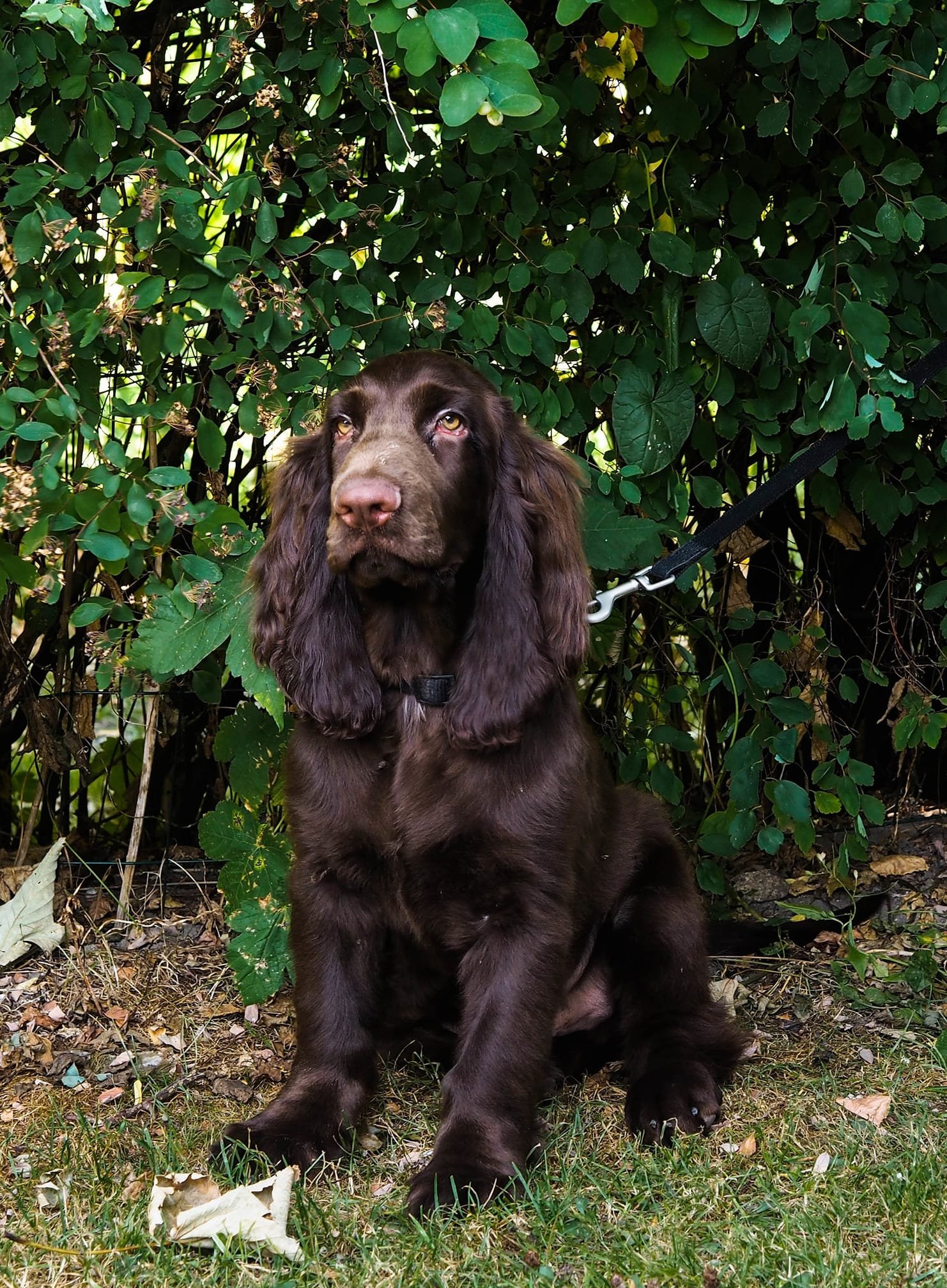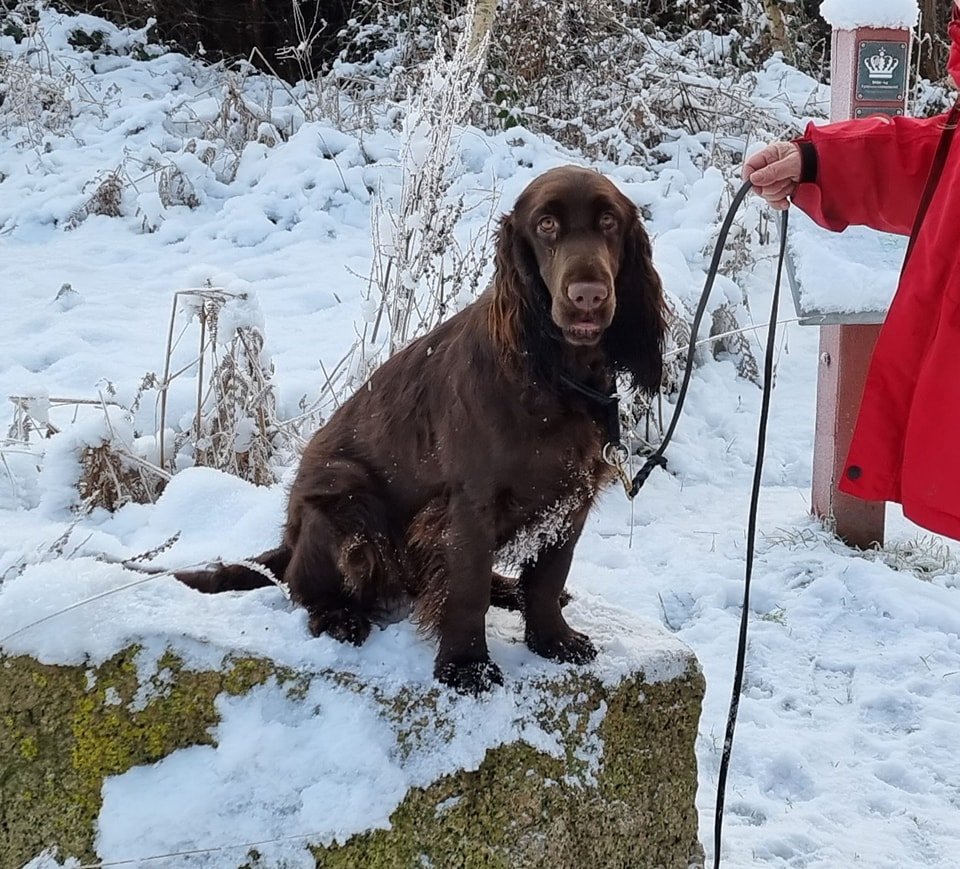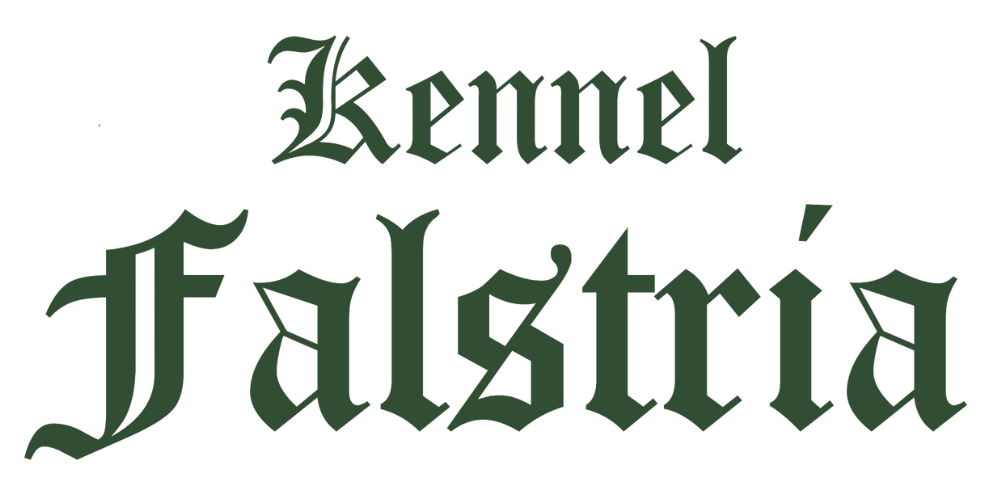
FIELD SPANIEL
Integrity and job satisfaction

Race History
The Field Spaniel is an old English hunting dog and of all the spaniel breeds the most noble in appearance.
The field spaniel breed is about 150 years old and is today one of the rarest of the spaniel breeds.
The spaniel breed has existed for many centuries and was divided into 3 categories: Toy, Land and Water spaniels.
The smallest spaniels were "toy" spaniels and were used as companion and guard dogs. They warmed up in bed at night and scolded if anyone came.
They are the ancestors of many of today's companion dogs such as. Papillon, cavalier king charles spaniel, tibetan spaniel etc.

The larger and working spaniels were divided into 2 categories: Water and land.
Water spaniels were the spaniels that were used as retrieving dogs on duck hunting. They form the basis of today's Water Spaniels.
Land spaniels specialized in finding and "hunting up" ("two jumps" in English) bird game.
In the beginning they were mostly used for falconry or net hunting, but later when hunting rifles were invented they were used "under the gun" for the hunter.
The smaller land spaniel was a favorite for hunting snapper ("Woodcock" in English) and was therefore named Cocker spaniel.
The slightly larger spaniels Field and Springer Spaniels were also mostly used for bird hunting but for the slightly larger birds. For many years, the difference between the jumper and the Field spaniel was nothing but the color.
From a litter of puppies all variegated puppies became Springer Spaniels and the full colored puppies were field spaniels.
During the latter half of the 19th century, the standard of the various spaniel breeds was set and documented and then the cocker, jumper, and field spaniel became more distinct breeds with their own distinctive characteristics, mentality, and appearance.
Character Traits of the Breed
A Field Spaniel's most characteristic feature is that it looks at its people. It is not a dog that immediately moves forward and jumps up by strangers, and it does not accept anyone.
This gives the impression of a certain dignity in the Field. It may be reserved, but never cloud. It simply has enough in itself and its own family and does not need to seek the attention of strangers.
If you treat your Field Spaniel with patience and kindness, you get a dog that is easy to work with. It will love making an owner comfortable and once it has learned something, it will never forget it again. It is very affectionate towards its owner, but not entirely without a certain amount of self-determination.
You can not "buy" a Field with treats if it has decided to want something else. It requires the owner to be creative, and come up with other kinds of rewards to motivate his field spaniel.
They are by nature very loyal to their owner and would very much like to keep their family together when they are outside the home. It feels best that everyone is nearby, but they are not shepherds. They just prefer to have everyone within sight as the family is its focal point.



WHO IS A FIELD SUITABLE FOR?
A Field Spaniel is a lively and happy dog with the family as its center. It is incredibly affectionate and enjoys a day at home (preferably on the sofa) as well as a whole day of hunting.
By temperament it is very phlegmatic which means that it does not allow itself to be influenced by the surroundings, it takes everything in stride and keeps it
As a working dog, it is pragmatic and independent, which means that when it has to work, it works, but when there is a break, it relaxes.
This is clearly seen in hunting where it struggles when you go through the sow where it performs its work independently and with drive, but when you wait between the sow, it typically lies down and sleeps.
No need to waste energy scolding or waiting for game when you have to start again in a little while. This also means that it is a dog that rarely stresses, and it is not a dog that barks, but instead "talks" a lot.
Health
Our goal is to get some hard-working, well-functioning and healthy dogs with breed-typical exterior and good temperament, therefore we look a lot at how the dogs combine each other
That they come from healthy and fresh blood lines, which can complement each other.
That they have the characteristics that Fielden is bred to from the very beginning of the breed.
has exteriors that live up to the standard, in appearance and appearance.
has a temperament that is well-functioning both in everyday life and for rehearsals and exhibitions.
Must be a dog that is all round - which can adapt to the tasks it is faced with.
We follow the breed club and the Danish Kennel Club's recommendations:
Breeding recommendations:
To get the Basis Plus pedigree with the text "This dog is bred according to the Spaniel Club's and DKK's breeding recommendations" the following must be met:
1. Begge forældredyr skal før parring have HD status A, B eller C registreret i DKK.
2. Begge forældredyr skal før parring være øjenundersøgt af et medlem af Den Danske Dyrlægeforenings øjenpanel eller anden af DKK godkendt øjendyrlæge og fundet fri for PRA og arvelig katarakt (1. Posterior polær subcapsulær katarakt – bagerste polstær – eller 2. Cortical katarakt – katarakt i linsens bark). Undersøgelsen kan tidligst foretages når hunden er 12 måneder gammel og en øjenattest må ikke være mere end 12 måneder gammel på parringstidspunktet. Hunde, der er øjenundersøgt og fundet fri for PRA og arvelig katarakt efter det fyldte 8. år, vil blive betragtet som permanent frie og vil ikke skulle øjenundersøges yderligere for at overholde avlsanbefalingerne.
3. For øvrige øjensygdomme gælder, at forældredyrene ikke må være registreret med samme øjensygdom i DKK. Undtaget herfra er distichiasis.
4. Begge forældredyr skal før parring være præmieret på en FCI/DKK anerkendt udstilling med mindst Very Good eller være eksteriørgodkendt på en eksteriørbedømmelse



